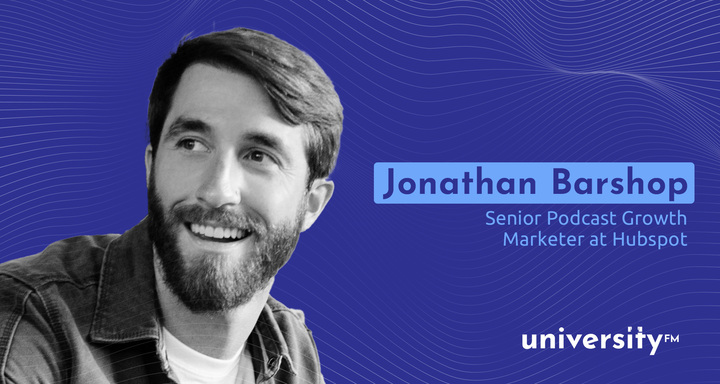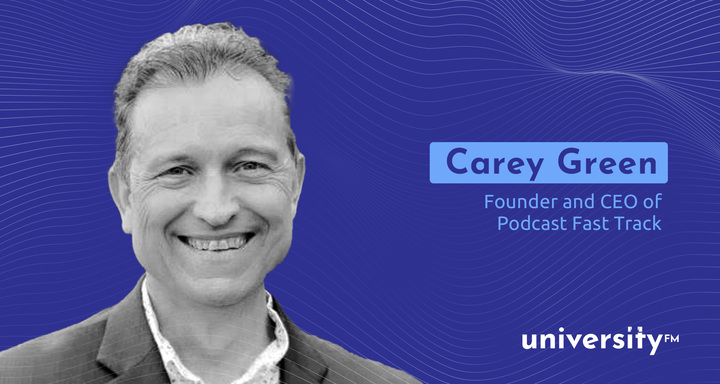Try to think of more conclusive proof of commitment, trust, and loyalty than listening to a person go on and on about a topic. It mostly takes around 5-7 minutes tops to read a blog post, or mostly just skim through it.
Podcasts, on the other hand, can last anywhere between 5 minutes and 7 hours. Whoever stays with you throughout is sure to be interested in what you have to say.
Additionally, blog posts are the most competitive type of content for people looking to attract audiences and build authority, meaning that competition is fierce.
In 2020 the number of bloggers in the US will reach 30+ million. That’s about 10% of the country. In contrast, there aren’t even a million active podcasts in the whole world.
So, if you want to feel heard and appreciated and plan on getting loads of passionate followers, podcasts are the way to go. Before you take off on your new platform, however, here are some essential steps on how to start a podcast.
Do Your Research – Identify Your Audience
Learning more about your audience takes place in several pre and post-launch stages. Before you come up with even the name for your podcast, though, you need to decide who you want to target.
What’s your niche, and what sort of people are usually interested in this subject you’ll be discussing?
The demographics of your Audience might often mirror the age/gender or overall interests of your host(s) as well. For example, younger people might be more inclined to trusting and listening to people their age.
Once you have done your best at guessing what your audience might look like, it’s time to start gathering information based on the people who are already following you. The moment you start posting and people start following you, find out as much as ethically possible about them.
What are their interests, their age, where do they spend most of their time online? When are they listening to your podcast? During a drive to work, or just before going to sleep?
This will help you find more people like them, and find out on which social networks and channels you should promote your podcast.
Finally, maybe several weeks or a month after the launch, you can start posting surveys. The best way to find out what you want to know about your audiences’ preferences and how to advance your brand to their liking? Simply ask.
Keep in mind that surveys shouldn’t take too long to fill in, and you shouldn’t distribute them too often. You don’t want to bombard your audiences with questions and tasks.
Podcast Topic and Name
You know how you can answer any question at a meeting with “it’s all about finding that balance” and appear as if you’d been paying attention? The same applies here. You’ll want to appeal to a broad audience, and still cover a niche topic.
For example, if your podcast is about fitness, you’ll want to cover all kinds of fitness goals. The name such as HIIT Champs might cut it for people who want to lose weight, but it would also alienate audiences looking to gain muscle.
A name such as Healthy Living might appear as a sound investment since you might want to include some dietary advice in the future, but the subject is simply too broad. Many of the people you have initially attracted are likely to ditch you as soon as the series progresses.
After you have come up with the name of your podcast, you need to try and purchase a domain name. Make sure you buy a domain as soon as you come up with a good idea, to prevent losing the spot to someone else.
Creating a Cover (Yes, it’s Art)
This is a key step on how to start a podcast. Your podcast cover art is the first thing your audience gets to see before clicking on your icon in the iTunes store and listening to the podcast. Other than the title, this is your first chance of attacking their senses and making yourself stand out from the crowd of similar audio content.
It’s of vital importance, therefore, that your cover art is striking, pleasing to the eye, and communicates your topic. If you already have a website logo and an established visual identity as a brand, your podcast cover art can reflect that.
You can find freelancers on Fiverr to do the cover art for you, or contact any cover design service whose work you find impressive. As for the details, you should go for at least 1400 x 1400 pixels, and save the cover in JPG or PNG form, under 500kb in size.
While you’ll get a pretty decent size design for your money, keep in mind that your listeners will only see a small thumbnail. Don’t clutter it with unnecessary details. Any detail that can’t be seen at 200px wide is superfluous.
Basic Episode Format
So, if you’re just starting, there’s really not much to work with when it comes to accommodating your audiences’ needs. You don’t have an audience yet, and all you can do is anticipate what they might be interested in.
This is why, at first, it’s a good idea to play it safe and use a predictive, run-of-the-mill format your audiences expect. This means episodic audio insights with one or two hosts, following a proven-to-work formula most others are applying:
- Intro music
- Announce episode topic
- Discuss the episode topic in detail
- Summarise and add a conclusion, say goodbye
- Outro music
This format works, and it’s been used time and time again in the industry, so your audiences will expect to hear it.
Now, the first big decision you need to make is whether you want to host the show yourself or invite a regular co-host. There are benefits and downsides to both decisions.
Additionally, this does not apply if you decide to do an interview format for your podcast. But remember, if you’re doing interviews with bigshots from your own, or related industries, you should probably have a decent listener base in place first.
If you don’t, it’s probably a good idea to start inviting gasts later on, after you have gathered a following.
The Benefits and Downsides of a Solo Show
As for the most obvious benefit, you get to keep all of the profits from the podcast, which is pretty enticing. You don’t have to worry about your co-host dropping out and leaving the project mid-show.
Also, you call all the shots. You decide on the sponsorships, partnerships, episode titles, topics to cover, etc.
On the other hand, the painful truth is that very few people on this Earth sound interesting and can deliver satisfying audio content on their own. You’d have to be either very talented or very hard-working to be able to carry a one-person show.
The Benefits and Downsides of a Co-Hosting
The most significant benefit is obviously that even with an average co-host can make your episode style effortlessly conversational, and therefore more appealing to audiences.
Also, you’ll get to play good cop and bad cop on several topics, debate, argue or even tease (don’t overdo it!) your co-host. This makes for a more dynamic, exciting listener experience.
On the downside, the question of authorship comes up, as well as of splitting the profits. You no longer call all the shots, and you make decisions together.
Episode Length, Seasonal Podcasts, Episode Frequency
Length
The length of each episode depends on two things – the content you want to convey and your audiences. If you can pack everything you can say on a certain topic in 30 minutes, then that’s your format.
If you’re doing a special or an interview, you can make an exception and do an hour and a half long show. It’s up to you.
This is all you can work with when you’re just starting out and don’t yet have a fan base. Once you acquire enough listeners, feel free to ask them about their preferred episode length. Consider their answers and make changes if need be.
Frequency
As for episode frequency, this is entirely up to you, and how much time you need to prepare.
Sure, you can make one extraordinary episode per month, and still make a significant impact. But keep in mind that the more frequent your uploads, the better.
Your audiences will get used to following you on a weekly basis, for example, and your relationship with them will be stronger. If this isn’t something you can keep up in the long run, though, don’t push yourself too hard.
Seasonal Podcasts
Finally, talking about seasonal podcasts, most podcasters keep their seasons related to a single topic.
For example, if your 10-episode season has to do with building a small business, every episode could be about one aspect of this huge, demanding project.
Seasonal podcasts also allow you to take breaks once the season is over. You can use this time to collect data to improve your future episodes, or just chill and focus on other matters.

Podcasting Technical Stuff – Equipment and Editing
Podcasts are not too pricey. As an investment, it will probably cost you around $400 per year tops. And that’s counting the equipment, being that most recording and editing software is free.
All you need to get you started are a computer, a USB microphone, and internet access. If you want pristine sound quality, though, you should invest in a quality mic. If you want to learn more about what equipment we recommend, you can read this article.
As for recording and editing software, you can take your pick. Audacity, GarageBand, and Pro Tools | First are all free recording and editing software. And they work like a charm.
Audacity is open-source software that offers cross-platform availability. GarageBand is preinstalled on all Mac computers, so you won’t even have to download it. Plus, it’s got some mean royalty-free music loops you can use in your episodes.
If you’re not satisfied with your everyday editing tools, you should give Pro Tools a chance. Hollywood producers use this tool for sound mixing, and you can add some exciting plugins if you want to spice things up in your podcast.
Spreading the Word
Once you have launched your podcast on iTunes, Youtube, MixCloud, or any other platform of your choice, it’s time to spread the word.
Work on marketing it, and building a solid listener base. Start with addressing the audiences you already have – your website visitors, past and repeat customers.
Announce your project on your social networks, on your website, and send emails to your subscribers. Start linking towards your podcast in the content you publish, such as blog posts and articles.
Then, you can work on sponsored ads campaigns on Facebook, Instagram, and other places where you can expect to find your audiences.
Once you’ve built a listener base, encourage your audience to share and comment on your podcast-related engagement and promotion posts. Word-of-mouth and a recommendation from a friend will go a long way when it comes to acquiring new listeners.
You can also work on giving awards, and planning giveaways at your podcast social media pages.
How to Start a Podcast Successfully
These are just basic tips on how to start a podcast that can become successful over time. Starting a podcast can be overwhelming for beginners. Luckily, there are plenty of resources out there for everyone willing to try.
If you need further guidance, we’re here to help you. PodcastPros is a podcast editing service provider that can help take your podcast to the next level. Check our list of services here. Let our Podcast in a Box service help you launch your organization’s podcast today!




